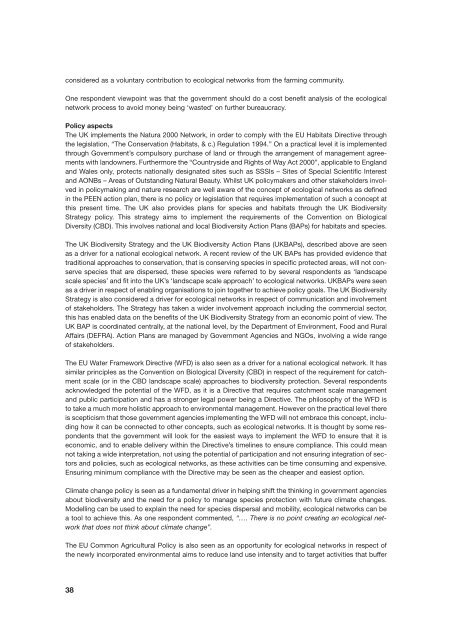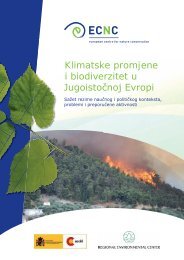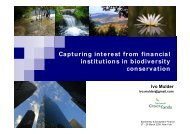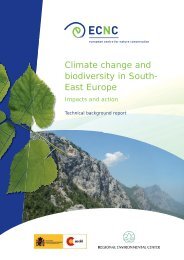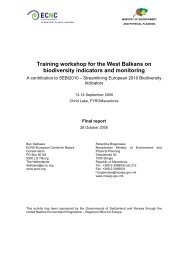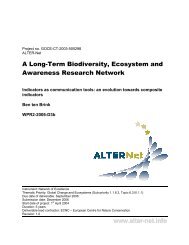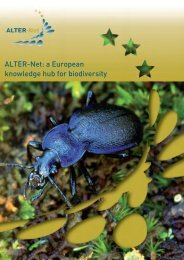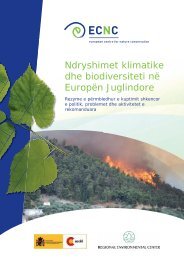2005 - Communicating the Pan-European Ecological Network - ECNC
2005 - Communicating the Pan-European Ecological Network - ECNC
2005 - Communicating the Pan-European Ecological Network - ECNC
Create successful ePaper yourself
Turn your PDF publications into a flip-book with our unique Google optimized e-Paper software.
considered as a voluntary contribution to ecological networks from <strong>the</strong> farming community.One respondent viewpoint was that <strong>the</strong> government should do a cost benefit analysis of <strong>the</strong> ecologicalnetwork process to avoid money being ‘wasted’ on fur<strong>the</strong>r bureaucracy.Policy aspectsThe UK implements <strong>the</strong> Natura 2000 <strong>Network</strong>, in order to comply with <strong>the</strong> EU Habitats Directive through<strong>the</strong> legislation, “The Conservation (Habitats, & c.) Regulation 1994.” On a practical level it is implementedthrough Government’s compulsory purchase of land or through <strong>the</strong> arrangement of management agreementswith landowners. Fur<strong>the</strong>rmore <strong>the</strong> “Countryside and Rights of Way Act 2000”, applicable to Englandand Wales only, protects nationally designated sites such as SSSIs – Sites of Special Scientific Interestand AONBs – Areas of Outstanding Natural Beauty. Whilst UK policymakers and o<strong>the</strong>r stakeholders involvedin policymaking and nature research are well aware of <strong>the</strong> concept of ecological networks as definedin <strong>the</strong> PEEN action plan, <strong>the</strong>re is no policy or legislation that requires implementation of such a concept atthis present time. The UK also provides plans for species and habitats through <strong>the</strong> UK BiodiversityStrategy policy. This strategy aims to implement <strong>the</strong> requirements of <strong>the</strong> Convention on BiologicalDiversity (CBD). This involves national and local Biodiversity Action Plans (BAPs) for habitats and species.The UK Biodiversity Strategy and <strong>the</strong> UK Biodiversity Action Plans (UKBAPs), described above are seenas a driver for a national ecological network. A recent review of <strong>the</strong> UK BAPs has provided evidence thattraditional approaches to conservation, that is conserving species in specific protected areas, will not conservespecies that are dispersed, <strong>the</strong>se species were referred to by several respondents as ‘landscapescale species’ and fit into <strong>the</strong> UK’s ‘landscape scale approach’ to ecological networks. UKBAPs were seenas a driver in respect of enabling organisations to join toge<strong>the</strong>r to achieve policy goals. The UK BiodiversityStrategy is also considered a driver for ecological networks in respect of communication and involvementof stakeholders. The Strategy has taken a wider involvement approach including <strong>the</strong> commercial sector,this has enabled data on <strong>the</strong> benefits of <strong>the</strong> UK Biodiversity Strategy from an economic point of view. TheUK BAP is coordinated centrally, at <strong>the</strong> national level, by <strong>the</strong> Department of Environment, Food and RuralAffairs (DEFRA). Action Plans are managed by Government Agencies and NGOs, involving a wide rangeof stakeholders.The EU Water Framework Directive (WFD) is also seen as a driver for a national ecological network. It hassimilar principles as <strong>the</strong> Convention on Biological Diversity (CBD) in respect of <strong>the</strong> requirement for catchmentscale (or in <strong>the</strong> CBD landscape scale) approaches to biodiversity protection. Several respondentsacknowledged <strong>the</strong> potential of <strong>the</strong> WFD, as it is a Directive that requires catchment scale managementand public participation and has a stronger legal power being a Directive. The philosophy of <strong>the</strong> WFD isto take a much more holistic approach to environmental management. However on <strong>the</strong> practical level <strong>the</strong>reis scepticism that those government agencies implementing <strong>the</strong> WFD will not embrace this concept, includinghow it can be connected to o<strong>the</strong>r concepts, such as ecological networks. It is thought by some respondentsthat <strong>the</strong> government will look for <strong>the</strong> easiest ways to implement <strong>the</strong> WFD to ensure that it iseconomic, and to enable delivery within <strong>the</strong> Directive’s timelines to ensure compliance. This could meannot taking a wide interpretation, not using <strong>the</strong> potential of participation and not ensuring integration of sectorsand policies, such as ecological networks, as <strong>the</strong>se activities can be time consuming and expensive.Ensuring minimum compliance with <strong>the</strong> Directive may be seen as <strong>the</strong> cheaper and easiest option.Climate change policy is seen as a fundamental driver in helping shift <strong>the</strong> thinking in government agenciesabout biodiversity and <strong>the</strong> need for a policy to manage species protection with future climate changes.Modelling can be used to explain <strong>the</strong> need for species dispersal and mobility, ecological networks can bea tool to achieve this. As one respondent commented, “…. There is no point creating an ecological networkthat does not think about climate change”.The EU Common Agricultural Policy is also seen as an opportunity for ecological networks in respect of<strong>the</strong> newly incorporated environmental aims to reduce land use intensity and to target activities that buffer38


